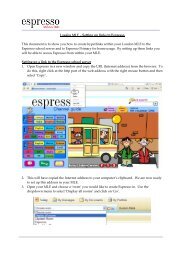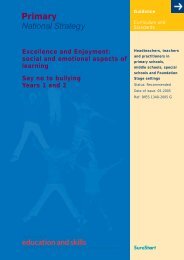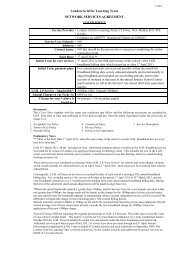Developing the home-school relationship using digital ... - Futurelab
Developing the home-school relationship using digital ... - Futurelab
Developing the home-school relationship using digital ... - Futurelab
- No tags were found...
You also want an ePaper? Increase the reach of your titles
YUMPU automatically turns print PDFs into web optimized ePapers that Google loves.
STRATEGIC CONSIDERATIONS3.3 PROBLEM-SOLVING33.3 PROBLEMSOLVINGCatching and acting on problems quicklyTeachers, children and parents generallyappreciate <strong>the</strong> role that a good <strong>home</strong>-<strong>school</strong><strong>relationship</strong> can play in resolving problemsthat children may be experiencing at <strong>school</strong>.Children may experience problems with<strong>the</strong>ir behaviour in <strong>school</strong>, <strong>the</strong>ir progress andachievement, or <strong>the</strong>ir social and emotionaladjustment. Identifying when a problem arisesand taking steps to tackle it quickly is crucialin making sure it does not become entrenched.Parents and teachers can sometimes bereticent to contact one ano<strong>the</strong>r about aproblem, unsure of <strong>the</strong> response <strong>the</strong>y willreceive. In some cases, by <strong>the</strong> time a parentcomes to <strong>school</strong> with a problem, <strong>the</strong>y and <strong>the</strong>irchild are angry and upset. A more trusting<strong>relationship</strong> can break down this reticenceand result in problems being addressedmore swiftly.Capturing, tracking and sharing data onchildren’s progress on a frequent basis is oneway in which problems can be identified at anearly stage by teachers, parents or children<strong>the</strong>mselves. Where children are falling behind,or repeatedly missing <strong>home</strong>work, waiting untilparents’ evening may mean a lost opportunityto address <strong>the</strong> problem, and that problembecoming more serious and more difficultto resolve. The online reporting expectationsinclude plans to make data on progressand behaviour available to parents, but it isimportant to consider how parents, childrenand teachers can act on <strong>the</strong> information <strong>the</strong>yreceive. For parents, <strong>the</strong> next step is usuallytalking to children to understand <strong>the</strong> issue,followed by talking to teachers to see what canbe done to address it. Tracking informationthrough online reporting has been used tosupport face to face ‘structured conversations’focused on listening to and learning fromparents and children in a project that aims toimprove <strong>the</strong> outcomes for children with specialeducational needs and disabilities 71 . Makingdata transparent <strong>the</strong>refore needs to be seenas <strong>the</strong> start of a conversation between parents,children and teachers, not an end point initself. Schools can <strong>the</strong>refore consider how <strong>the</strong>ycan present data in ways that facilitate suchproductive conversations.A good <strong>relationship</strong> between parentsand teachers also means that consistentexpectations of children’s behaviour can beshared between <strong>home</strong> and <strong>school</strong>, meaningthat <strong>the</strong>y are less likely to ‘play off’ teachersand parents against one ano<strong>the</strong>r. <strong>Developing</strong><strong>the</strong>se expectations needs to be done inconsultation with parents and children, sothat <strong>the</strong> <strong>school</strong> and <strong>home</strong> work to a set ofshared values. As well as asking parents tosupport <strong>the</strong> <strong>school</strong>’s policies, <strong>the</strong> <strong>school</strong> is ina stronger position when it also understandsand reinforces <strong>the</strong> expectations that childrenlive up to at <strong>home</strong>. Communication aboutbehaviour needs to happen as close to <strong>the</strong>event as possible in order to have an effectand to reflect a consistent message across<strong>the</strong> <strong>school</strong>; <strong>digital</strong> technologies can supportthis swift communication and help co-ordinatemessages across <strong>the</strong> <strong>school</strong> (see also ‘See <strong>the</strong>Bigger Picture’).“If you’re in trouble <strong>the</strong>n if your parentsknow <strong>the</strong>y can talk to you and help you sussit out.” (Year 10 student)Addressing problems with <strong>school</strong>Inevitably, <strong>the</strong>re are times when childrenor parents have a problem with somethinghappening in <strong>school</strong>, or a complaint abouthow <strong>the</strong> <strong>school</strong> has approached or dealt withan issue. When <strong>the</strong>se complaints are serious,<strong>the</strong>re needs to be a straightforward policy forhow <strong>the</strong>y are dealt with, and in most <strong>school</strong>sthis is in place. However, parents also wantto be able to provide feedback to <strong>the</strong> <strong>school</strong>in a ‘low-key’ way, providing suggestions forimprovement or letting <strong>the</strong> <strong>school</strong> know whenthings have not gone quite right. Bringingsuch feedback into <strong>the</strong> <strong>school</strong> providesano<strong>the</strong>r perspective for <strong>the</strong> <strong>school</strong> to use in itsdevelopment, and can also stem <strong>the</strong> circulationand escalation of complaints that canundermine <strong>the</strong> <strong>school</strong> if not addressed. Digitaltechnologies can provide easy mechanismsfor such feedback, as well as making publicresponses where appropriate.Involving children in finding a solutionChildren are very clear that <strong>the</strong>y want to beinvolved in <strong>the</strong> problem solving process, as <strong>the</strong>yare <strong>the</strong> key players and solutions developedwithout <strong>the</strong>ir input have a more limited chanceof being successful. Children often feel <strong>the</strong>y donot have legitimate authority to raise problemsat <strong>school</strong> on <strong>the</strong>ir own, and usually turn toparents in <strong>the</strong> first place for support.4071. The ‘structured conversation’ approach could easily be applied to any children experiencing problems within <strong>school</strong>. For moreinformation on <strong>the</strong> ‘Achievement for All’ programme and structured conversations, seenationalstrategies.standards.dcsf.gov.uk/node/253403?uc=force_uj
















